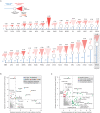Pan-cancer inference of intra-tumor heterogeneity reveals associations with different forms of genomic instability
- PMID: 30212491
- PMCID: PMC6155543
- DOI: 10.1371/journal.pgen.1007669
Pan-cancer inference of intra-tumor heterogeneity reveals associations with different forms of genomic instability
Abstract
Genomic instability is a major driver of intra-tumor heterogeneity. However, unstable genomes often exhibit different molecular and clinical phenotypes, which are associated with distinct mutational processes. Here, we algorithmically inferred the clonal phylogenies of ~6,000 human tumors from 32 tumor types to explore how intra-tumor heterogeneity depends on different implementations of genomic instability. We found that extremely unstable tumors associated with DNA repair deficiencies or high chromosomal instability are not the most intrinsically heterogeneous. Conversely, intra-tumor heterogeneity is greatest in tumors exhibiting relatively high numbers of both mutations and copy number alterations, a feature often observed in cancers associated with exogenous mutagens. Independently of the type of instability, tumors with high number of clones invariably evolved through branching phylogenies that could be stratified based on the extent of clonal (early) and subclonal (late) instability. Interestingly, tumors with high number of subclonal mutations frequently exhibited chromosomal instability, TP53 mutations, and APOBEC-related mutational signatures. Vice versa, mutations of chromatin remodeling genes often characterized tumors with few subclonal but multiple clonal mutations. Understanding how intra-tumor heterogeneity depends on genomic instability is critical to identify markers predictive of the tumor complexity and envision therapeutic strategies able to exploit this association.
Conflict of interest statement
The authors have declared that no competing interests exist.
Figures




References
-
- McGranahan N. and Swanton C., “Clonal Heterogeneity and Tumor Evolution: Past, Present, and the Future,” Cell, vol. 168, no. 4, pp. 613–628, February 2017. - PubMed
-
- Negrini S., Gorgoulis V. G., and Halazonetis T. D., “Genomic instability—an evolving hallmark of cancer,” Nat. Rev. Mol. Cell Biol., vol. 11, no. 3, pp. 220–228, March 2010. - PubMed
-
- Nowell P. C., “The clonal evolution of tumor cell populations,” Science, vol. 194, no. 4260, pp. 23–28, October 1976. - PubMed
-
- Burrell R. A., McGranahan N., Bartek J., and Swanton C., “The causes and consequences of genetic heterogeneity in cancer evolution,” Nature, vol. 501, no. 7467, pp. 338–345, September 2013. - PubMed
Publication types
MeSH terms
Substances
LinkOut - more resources
Full Text Sources
Other Literature Sources
Research Materials
Miscellaneous

